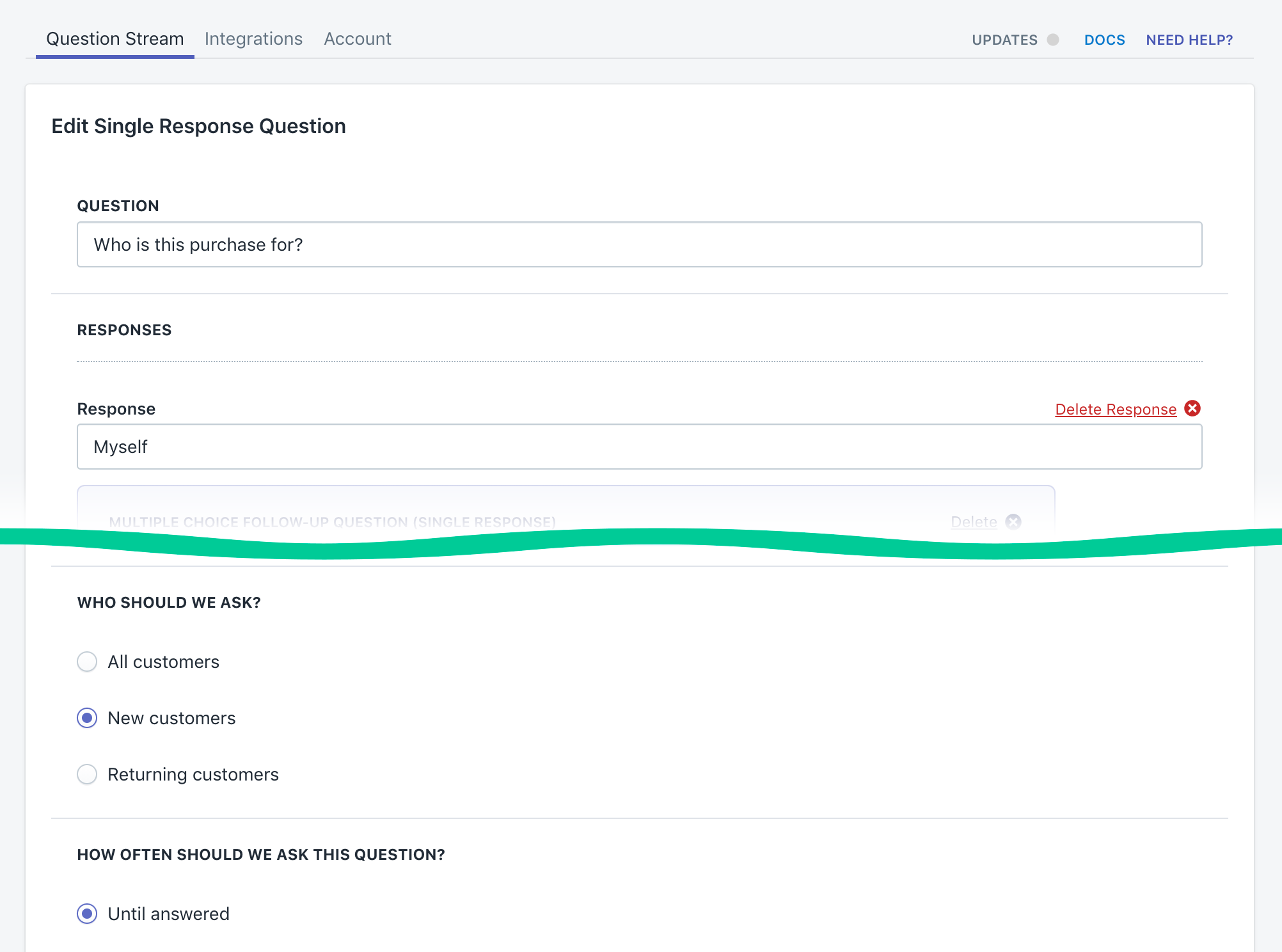QOTD: Who Is This Purchase For? The Buyer vs User Problem
In today’s Question Of The
Day ,
we’re going to tackle the Buyer vs User problem with the simplest of
solutions: a single question that lets customers
self-segment
, and subsequently helps to keep your audiences (and business metrics)
tidy.
The Buyer vs User problem plagues most businesses, whether they’re
selling sunglasses DTC, or selling software B2B. It’s the challenge of
having to market and sell your product to someone who is purchasing on
behalf of someone else.
In some corners of commerce, this is just the nature of the beast. One
good example is the Toys & Games category; there’s virtually zero
overlap between the people who buy these products and the people who use
them. What’s more, the buyers often have totally unrelated (or even
opposing) value criteria from the users, such as price or build quality.
But interestingly, the Buyer vs User problem occasionally pops up in
almost every category when the purchase in question is a gift. Think
about Housewares : wedding & baby registry gifts, housewarming
gifts, Mother’s Day gifts… even though Housewares is a staple category
for any home, there’s no shortage of occasions where the product
purchased is intended for someone else.
What’s tricky about the gifting audience (those of your customers who
are buyers, but not users) is that they’re unlikely to identify
themselves -- and depending on what ratio of your customer base they
make up, that audience can throw a wrench into your ability to analyze
retention and engagement. What’s more, it’s obvious that you’re not
delivering the optimal customer experience to a buyer if you mistakenly
assume they’re a user.
Luckily, there’s a fix for that… and you can plug it right into your
checkout flow.
Who Is This Purchase For?
Crack open your Fairing Question
Stream™ , and set up
this simple question to ask New Customers, Until Answered. Our
recommended response options are below, but follow your heart (and your
market fit):
- Myself
- Friend or family member
- Co-worker or client
- Other

Like many post-purchase survey questions, this one packs a ton of
insight into a simple DFC interaction. Let’s take a look at some of the
learnings to be had here:
First and foremost, any answer other than “Myself” automatically
segments the shopper as a buyer, not a user. This distinction is crucial
for your marketing automation workflows (especially if you don’t already
have a workflow for gift-givers), to ensure you’re delivering the most
useful content. After all, this is a potential future customer who
already knows what you offer, and where to get it -- and they know
someone else who advocates for the product. You’ve cleared so many
hurdles to a conversion by this point!
Segmenting the gift-giver audience also helps to clean up your
performance metrics. Splitting your customers between the Buyer vs User
will typically reveal the former group to have higher churn and lower
content engagement, to say the least. You’ll get a better idea of how
your custom relationships perform and trend once you’ve split these
groups up.
Of course, that’s not to say buyers are all low-volume, one-and-done
shoppers. One of the reasons we suggest the aforementioned response
options is that a gift-giver can often have a more predictable
repurchase window than a traditional customer. “Co-worker or client”
respondents, for instance, might be open to purchasing several of the
same product for different users, or repurchasing during the holiday
season -- a sales opportunity made even more appealing by the fact that
such buyers are likely swiping corporate cards rather than digging into
their own pockets. “Friend or family member” respondents purchasing for
a birthday or holiday can easily be reminded as the next notable date on
the calendar approaches (do you still get those 1-800-Flowers email
reminders that it’s your aunt’s birthday next week? Yeah, us too.)
Beyond that, learning what products perform best as gifts can guide
additional business metrics and decisions. One Fairing client, Pastreez,
used the “Who is this purchase for” question to get a grip on the
variance of their AOV: when the dust settled on customer responses, a
clear distinction emerged between user AOV and buyer AOV, where the
latter segment was spending 100% more per order.

All these insights are made more powerful when you ask a follow-up
question or
response clarification using our platform. Here are a few rather unique
tactics, once the first response segments the shopper as a gift-giver:
- “What convinced you to buy this product?” Get a pulse on the drivers
behind your gift audience potential by finding out how many bought
because of price, as opposed to a particular selling point, or
simply because the recipient asked for the product.
- “Would you ever consider this product for yourself?” Confront the
opportunity head-on and learn whether this shopper should be in your
pipeline; route them to the appropriate automation workflow based on
their answer.
- “How will you describe this product to the recipient?” A
refreshingly left-field question, as any good entrepreneur will tell
you that the people who pitch their products best are the customers.
Ask this to gather a slew of consumer-generated one-liners and
keywords.
The options are endless for what you can ask as a follow-up here, and if
you’d like to check out some more, see our Question
Bank for
best practice questions submitted by top performing DTC brands and
survey methodologists.
In closing: no matter what you sell, you’ve got a Buyer vs User problem
-- but just by talking to your customers, you can turn it into
opportunity.
This article is part of our Question Of The Day
(QOTD)
series, where Fairing teams up with the industry’s smartest qualitative
marketers to deliver best practices and unique perspectives in the art &
science of questions. Are you a question authority? If so, our customers
would love to hear from you.